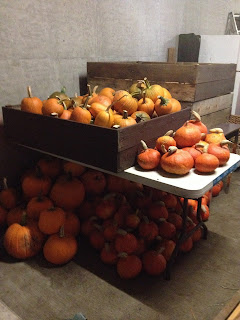For next year, the class is thinking of trying Spaghetti Squash and Blue Kuri Kabocha Squash and not so many pumpkins. The Orange Summer Kuri and the Galeux d'Eysines did well as they were sweet and good for eating. The corn didn't take well, most likely because of the high wire worm population in the field. We tried the variety Luscious but were not happy with it, so next year will probably be Peaches & Cream as it is sweet and very popular. In the Terrace garden, we somehow got a melon plant in with the summer squash and it did well so next year the class will probably grow some melons. The Hakurei Turnip is white with a crisp texture, nice for eating raw. Once people tried it, it became popular so next season the class will definitely grow more. We tried sweet potato not knowing if it would be warm enough for it, but it seemed to do ok. So the class will try it again next season, planting it earlier than we did this year. The spring was really warm and made it hard to grow a lot of the greens because they like cooler weather and they just bolted. We planted too many beans for the size of our class and we couldn't keep up with the harvest and most of it got tiller under. Not a loss, as it makes a good nitrogen fixer and organic matter.
We collected more seed from the hulless pumpkins for the trial.
A inexpensive oil press was purchased to extract the oil from the seeds, but it didn't work well so.
We did figure out that the seeds were approximately half oil to half meal and the amount of oil worked out to be about two percent of the weight of the pumpkin.
But before pressing, the seeds needed to be roasted.
Out at the Orchard, the garlic we planted is starting to grow and the cover crops are doing well.
It's a little sad that the Agroecosytems Management classes are coming to an end, as it has been a lot of fun, a great group of people to work with, and a great learning experience. Part of it has been hard work - digging up potatoes, some parts a bit monotonous - picking beans, learning that tractors (even though they use fossil fuels) do certain jobs in a fraction of the time - tilling the beds (priceless!) and honestly I personally would not be able to do the physical work for very long before being worn out. I think life is about balance, and it is especially true for agriculture. Farming sustainably is not about going backwards, it's about looking at the whole picture and seeing what we are doing wrong for the environment and what we can do to work within the environment/nature. Learning about the natural ecosystems and how they work. By doing things like farmscaping, providing habitat for the native predators of the pests on the farm instead of using insecticides that tend to kill a wide range of insects the bad and the good. Just to have the pest populations bounce back faster than the predator populations, meaning you have to continue to use insecticides creating an unhealthy vicious cycle. There is still so much to learn about sustainable farming, and this program is a great place to start.
.

























 S
S




































